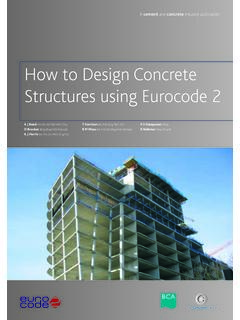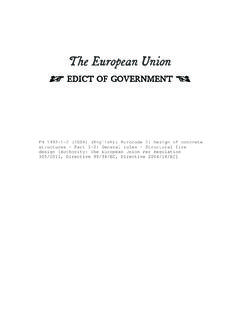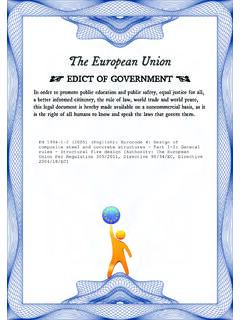Transcription of EN 1990: Basis of structural design
1 Eurocode Training EN 1990: Basis of structural design Eurocode Training EN 1990 2 All information in this document is subject to modification without prior notice. No part of this manual may be reproduced, stored in a database or retrieval system or published, in any form or in any way, electronically, mechanically, by print, photo print, microfilm or any other means without prior written permission from the publisher. SCIA is not responsible for any direct or indirect damage because of imperfections in the documentation and/or the software. Copyright 2015 SCIA nv. All rights reserved. Table of contents 3 Table of contents Overview .. 5 EN 1990: Basis of structural design .. 6 Section 1: General .. 7 Scope: .. 7 Assumptions .. 7 Distinction between Principles and Application Rules .. 7 Terms and definitions .. 8 Symbols .. 8 Section 2: Requirements .. 9 Basic requirements.
2 9 Reliability management .. 10 design working life .. 12 Durability .. 13 Quality Management .. 13 Section 3: Principles of limit states design .. 14 General .. 14 design situations .. 14 Ultimate limit states .. 14 Serviceability limit states .. 14 Limit state design .. 15 Section 4: Basic variables .. 16 Actions and environmental influences .. 16 Material and product properties .. 17 Geometrical data .. 17 Section 5: structural Analysis and design assisted by testing .. 18 Section 6: Verification by the partial factor method .. 19 General .. 19 Limitations .. 19 design values .. 19 Ultimate limit state .. 20 Serviceability limit state .. 27 Example: Combinations in SCIA Engineer according to the EN 1990 .. 30 References .. 40 Eurocode Training EN 1990 4 Eurocode Training EN 1990 5 Overview The structural Eurocode programme comprises the following standards generally consisting of a number of Parts: EN 1990 Eurocode: Basis of structural design EN 1991 Eurocode 1: Action on structures EN 1992 Eurocode 2: design of concrete structures EN 1993 Eurocode 3: design of steel structures EN 1994 Eurocode 4: design of composite steel and concrete structures EN 1995 Eurocode 5: design of timber structures EN 1996 Eurocode 6: design of masonry structures EN 1997 Eurocode 7: Geotechnical design EN 1998 Eurocode 8: design of structures for earthquake resistance EN 1999 Eurocode 9: design of aluminium structures Eurocode Training EN 1990 6 EN 1990: Basis of structural design The following subjects are dealt with in EN 1990: Section 1: General Section 2: Requirement Section 3.
3 Principles of limit states design Section 4: Basis variables Section 5: structural analysis and design assisted by testing Section 6: Verification by the partial factor method National annex for EN 1990 This standard gives alternative procedures, values and recommendations for classes with notes indicating where national choices may have to be made. Therefore the National Standard implementing EN 1990 should have a National annex containing all Nationally Determined Parameters to be used for the design of buildings and civil engineering works to be constructed in the relevant country. National choice is allowed in EN 1990 through : (1) (1) (Table ) (1) (Tables (A) to (C)) (5) (Table ) (2) Eurocode Training EN 1990 7 Section 1: General Scope: EN 1990 is an material-independent operational code of practice that establishes the principles and requirements for safety and serviceability and describes the Basis for their design and verification.
4 It also provides guidelines for the aspects of structural reliability and durability. Assumptions The choice of the structural system and the design of the structure is made qualified and experienced personnel. The execution is carried out by personnel with appropriate skill and experience. During execution, adequate supervision and quality control is provided. The construction materials and products are used as specified in EN 1990 or in EN 1991 to EN 1999 or in the relevant execution standards, or reference material or product specifications. Adequate maintenance will be provided on the structure . The structure will be used in the way it is defined by the design assumptions. Distinction between Principles and Application Rules A principle is a general statement or definition for which there s no alternative or for which there is no alternative allowed. The Application Rules are generally recognized rules which comply with the Principles and satisfy their requirements.
5 Eurocode Training EN 1990 8 Terms and definitions For the structural Eurocode, attention is drawn to the following key definitions, which may be different from current national practices: Action means a load, or an imposed deformation ( temperature effects or settlement) Effects of Actions or Action effects are internal forces, bending moments, shear forces and deformations caused by actions. Strength is a mechanical property of a material, in units of stress. Resistance is a mechanical property of a cross-section of a member, or a member or structure . Execution covers all activities carried out for the physical completion of the work including procurement, the inspection and documentation thereof. The term covers work on site; it may also signify the fabrication of components off site and their subsequent erection on site.
6 Symbols Actions (F) Permanent Actions (G) Variable Actions (Q) Accidental Actions (A) Seismic Action (Ae) Values of Actions: Representative Values of Actions Characteristic Value (Qk) Combinations Value of a Variable Action ( 0Qk) Frequent Value of a Variable Action ( 1Qk) Quasi-permanent Value of a Variable Action ( 2Qk) Eurocode Training EN 1990 9 Section 2: Requirements Basic requirements: The fundamental requirements stipulate that: structure shall be designed and executed in such a way that it will, during its intended life and with appropriate reliability and in economical way: Sustain all actions and influences which can occur during execution and use Remain fit for the use for which it is required A structure must have adequate: structural resistance (ULS) Serviceability (SLS) Durability: The structure needs to be designed in such a way that during its intended life, the use of structure shall be guaranteed taking into account its environment and the foreseen maintenance.
7 In the case of fire , the structural resistance shall be adequate for the required period of time. The structure shall be designed and executed in such a way that it will not be damaged by events as: Explosion Impact Consequences of human errors to an extend disproportionate to the original cause. Figure: Damage caused by explosion Potential damage shall be avoided by: avoiding, eliminating or reducing the hazards to which the structure can be subjected selecting a structural form which has low sensitivity to the hazards which are considered selecting a structural form and design that can survive adequately: o the accidental removal of an individual member or a limited part of the structure o the occurrence of acceptable localized damage Eurocode Training EN 1990 10 Figure: Part of the structure is removed. avoiding as far as possible structural systems that can collapse without warning tying the structural members together The requirement above can be met by choosing suitable materials, an appropriate design and detailing and by specifying control procedures for design , production, execution and use.
8 Reliability management An appropriate degree of reliability for the majority of structures is obtained by design and execution according to Eurocodes 1 to 9, with appropriate quality assurance measures. EN 1990 provides guidance for obtaining different levels of reliability. The choice of the levels of reliability for a particular structure should take into account: the possible cause and /or mode of attaining a limit state the possible consequences of failure in terms of risk to life, injury, potential economical losses Table B1: Definition of consequences classes public perception to failure Public perception does not accept fatalities and injuries due to structural failure (at home, at the work place, during recreational and other activities etc), for the design working life of a structure . The accepted risk of death is compared to fatalities arising from other hazards and events.
9 The expense and procedures necessary to reduce the risk of failure. Eurocode Training EN 1990 Table: Accepted risk of death due to exposure to various hazards(Risk expresssed as a probability of death for typical exposed person per calendar year) The theoretical Basis of the partial factor method and procedures for material properties and actions is based on probabilistic methods. The basic reliability elements considered in these procedures include probability of failure Pequivalent reliability index ) corresponding to a certain reference period T used in verification of structural reliability. The reference period T may or may not coincide with the design working life Twhich is the time period during which the a structure is required to perform ad Table B2: Recommended minimum values for reliability index (ultimate limit state) Table: Accepted risk of death due to exposure to various hazards(Risk expresssed as a probability of death for typical exposed person per calendar year) The theoretical Basis of the partial factor method and procedures for determination of partial factors of material properties and actions is based on probabilistic methods.
10 The basic reliability elements considered in these procedures include probability of failure P) corresponding to a certain reference period T used in verification of structural reliability. The reference period T may or may not coincide with the design working life Twhich is the time period during which the a structure is required to perform C1: Relation between and Pf Table B2: Recommended minimum values for reliability index (ultimate limit state)11 Table: Accepted risk of death due to exposure to various hazards (Risk expresssed as a probability of death for typical exposed person per calendar year) determination of partial factors of The basic reliability elements considered in these procedures include probability of failure Pf (or ) corresponding to a certain reference period T used in verification of structural reliability. The reference period T may or may not coincide with the design working life Td , equately.

![[Eng]Tutorial Plate Concrete 18.0 - downloads.scia.net](/cache/preview/f/9/b/5/e/7/6/0/thumb-f9b5e760b4520cd55b920677be8e404d.jpg)







